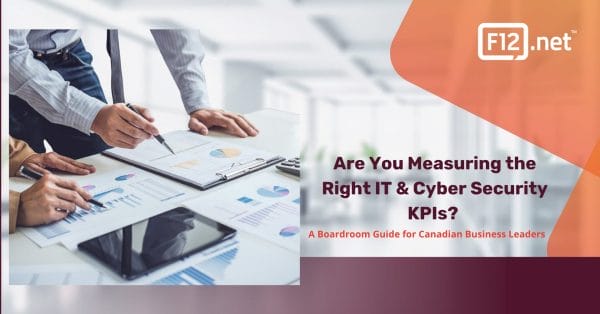Brief: Intellectual property (IP) theft is a major issue for businesses, and can have far reaching impact on your competitiveness, finances, and reputation. In this article, we look at why protecting against intellectual property theft is important, how it happens, and challenges companies here in Canada face in protecting their IP from cyber criminals.
“It’s ours, it is, and we wants it. The thieves, the thieves, the filthy little thieves. Where are they with my Precious?”
— Golum, The Two Towers
Intellectual property (IP) theft is a major issue for businesses, and not just the big players but for small businesses as well. In Canada, for instance, there have been several notable cases that highlight the risks and impacts.
One prominent example from a few years back involved a technology firm in Quebec that suffered from IP theft by a former employee. This employee took proprietary data and used it to start his own competing business in the same field. This type of insider threat is particularly dangerous because it involves individuals who already have authorized access to sensitive information.
Another more general trend we’re seeing involves cyber attacks aimed at extracting valuable IP from companies. These aren’t always the headline-grabbing massive breaches but can be targeted attacks that siphon off critical data slowly and stealthily.
Industries like biotech, engineering, and even fashion and entertainment in Canada have been targets. What makes it challenging is that often, small businesses aren’t even aware that their IP is being stolen until they see a competitor in another country releasing a remarkably similar product.
For example, here are four statistics relating to IP-related cybercrime in Canada, demonstrating the breadth and impact of these issues on Canadian businesses:
- Incidence of Cybercrime: A substantial number of Canadian businesses are affected by cybercrime. In 2021, 78% of companies experienced at least one cyber attack, and this figure rose to 85.7% in the following year.
- Cost of Data Breaches: The financial implications are significant; the average cost of a data breach in Canada was reported at $5.4 million in 2021, illustrating the high stakes involved in cyber security for Canadian businesses.
- Ransomware Attacks: Ransomware remains a critical threat, with 65% of Canadian companies expecting to face such an attack. The average cost to resolve a ransomware incident in Canada is nearly $2 million, highlighting the expensive fallout from such breaches.
- Reporting and Response: Despite the prevalence of cyber incidents, only 10% of businesses impacted by cyber security incidents in 2017 reported them to police services, indicating a potential underreporting and a gap in collaborative defence against cybercrime.
Source 1: Made in CA
Source 2: Statistics Canada
As you can see, IP-related cybercrime is a huge concern, yet it seems that very few incidents are reported as they should be.
Why Protecting Your IP is More Important Than Ever
As businesses increasingly operate on a global scale, leveraging the internet and digital platforms, the exposure to potential IP theft expands dramatically. Information that once was confined to secured physical locations is now often stored online, accessible potentially from anywhere in the world. This increased digital footprint makes it crucial to have robust protections around IP.
At the same time, IP is a critical asset that can define the competitive edge and market value of a company. Innovations, creative works, unique designs, and trade secrets can represent significant investments and potential revenue streams. Protecting these assets is essential to preserving business value and securing revenue growth.
In addition, protecting your IP also ensures that inventors, creators, and businesses can reap the benefits of their innovations, which in turn fuels further innovation and investment in new technologies and creative outputs.
Similarly, in highly competitive markets, the uniqueness guaranteed by IP rights can help a business stand out. Protecting these rights ensures that unique products, services, or processes remain exclusive to the original creators.
Externally, the rate of cybercrime is increasing, with sophisticated methods being used to target business assets, including IP. Hackers and cybercriminals are continuously developing new techniques to breach security measures, making it imperative that businesses also evolve their protective strategies.
Finally, as companies increasingly outsource parts of their operations and collaborate with external partners globally, the risk of IP leakage or theft grows. Effective IP protection strategies are crucial in these collaborative and outsourced environments to ensure that all parties respect and protect shared intellectual assets.
Given these factors, businesses must prioritize and continually reassess their IP protection strategies to ensure they remain effective against new and evolving threats.
Intellectual Property Theft: Why it’s Invisible
The underreporting of IP-related cybercrime is a significant issue, and there are several reasons why this might happen.
First, many businesses may not even realize that their intellectual property has been compromised until it’s too late. This lack of awareness can be due to the subtlety of some cyber attacks, where the theft occurs unnoticed over extended periods.
In addition, some companies might choose not to report IP theft because they fear the negative publicity could harm their reputation. Admitting to a breach may lead clients, partners, and investors to perceive the company as less secure, potentially impacting business relationships and financial stability.
Sometimes, intellectual property theft can be complex to detect and even harder to prove. The digital nature of the crime and the often international scope of cyber attackers make it difficult to track and substantiate claims, which can deter businesses from reporting it.
Often, pursuing legal action can be costly and time-consuming. Companies might feel that the potential costs outweigh the benefits, especially if the chance of recovering the stolen IP or securing a conviction is low.
Furthermore, in many small and medium-sized enterprises, in particular, may lack the necessary resources to effectively deal with IP theft. This includes having dedicated personnel to handle cyber security, conduct regular audits, and manage the aftermath of a breach.
Lastly, businesses might not have sufficient legal or cyber security support to understand the implications of the theft or how to proceed with reporting it. This lack of support can lead to underreporting.
In spite of these, the costs are high, and the potential for IP theft is high.
Let’s take a look at the top ways criminals can use tech to steal your IP.
Top 10 Ways Intellectual Property Theft Happens
Intellectual property (IP) can be stolen in numerous ways through technology, often exploiting digital vulnerabilities or human error.
Here are the ten most common methods through which IP is stolen technologically and a hypothetical scenario for each:
Insider Threats: Employees or contractors with access to company networks can intentionally or unintentionally leak IP. This could be through misuse of access privileges or accidental sharing of information.
Intellectual Property Theft Scenario: An employee at a software development firm uses their admin privileges to download and send proprietary algorithm details to a competitor motivated by a lucrative job offer from another company.
Social Engineering: Beyond phishing, social engineering includes a range of manipulative techniques aimed at duping people into breaking normal security procedures to gain unauthorized access to systems or reveal confidential information.
Intellectual Property Theft Scenario: A legal assistant at a small law firm receives a call from someone claiming to be from the firm’s IT services, asking for her credentials to resolve a supposed network issue. She provides them, unknowingly granting access to sensitive client files.
Cloud Storage Insecurity: Insufficient security measures in cloud services can lead to unauthorized access and theft of IP stored in the cloud.
Intellectual Property Theft Scenario: A marketing agency stores client project files and creative materials on a less reputable cloud storage service without adequate security measures. Hackers exploit a vulnerability in the service’s security to access and steal upcoming marketing campaigns.
Unsecured Networks: Using unsecured or poorly secured networks can allow attackers to intercept data being transmitted across these networks, including confidential IP.
Intellectual Property Theft Scenario: The owner sets up a Wi-Fi network for customer use without proper security protocols. Cybercriminals use this network to intercept communications between the shop and its suppliers, gaining access to new proprietary coffee blend recipes.
Data Breaches: Breaches can occur through hacking, where attackers exploit security weaknesses to gain unauthorized access to IP stored in digital formats.
Intellectual Property Theft Scenario: A retail business fails to update its point-of-sale systems, which are then targeted by hackers using known exploits. The attackers gain access to the system and exfiltrate proprietary sales data and upcoming product details.
Phishing Attacks: Cybercriminals use deceptive emails or messages that appear legitimate to trick employees into providing sensitive information or accessing malicious websites that can steal IP data.
Intellectual Property Theft Scenario: An accountant receives an email that mimics the appearance of a trusted software provider’s communication, urging an immediate download of an update to continue services. The link leads to a malicious site that installs spyware to gather financial data.
Malware: Malicious software can be installed on a system through deceptive downloads or email attachments. Once installed, malware can steal data, including IP, and send it back to the attacker.
Intellectual Property Theft Scenario: An employee of a small manufacturing company downloads a seemingly harmless application from an email sent by an unknown sender. The application is actually malware that extracts machine design files from the company’s network.
Ransomware: This type of malware encrypts valuable data, including IP, and demands a ransom for the decryption key. During the attack, thieves can copy the encrypted data for their use.
Intellectual Property Theft Scenario: A dental clinic’s systems are infected with ransomware after an employee clicks a malicious link in an email. The ransomware encrypts patient records and treatment plans, and the attackers demand a ransom to decrypt the data.
Espionage/Spyware: This involves using software tools that secretly monitor system activities and gather sensitive information, including IP details, which are then transmitted to a third party.
Intellectual Property Theft Scenario: A competitor installs spyware on the laptop of a lead researcher at a biotech startup during a conference. The spyware sends back data about a new drug compound the startup is developing.
Physical Theft: Loss or theft of devices like laptops, smartphones, and external hard drives containing IP can lead to unauthorized access if these devices are not adequately secured.
Intellectual Property Theft Scenario: An architect leaves their laptop in their car while running an errand before a meeting. The laptop, which contains confidential blueprint designs for upcoming projects, is stolen.
As you can see, it’s quite easy for your IP to get out to the world.
But so what, you ask? I don’t really have anything of importance, so what could even happen?
The “Intellectual Property Theft Can’t Happen to Me” Fallacy
While it might seem like the likelihood of intellectual property (IP) theft is low, especially for small businesses like yours that might not believe you’re a typical target, the reality can be quite different. Here’s why taking the Intellectual Property Theft seriously is important:
Everyone is a Target: Contrary to popular belief, small businesses are frequent targets of cyberattacks precisely because they often have weaker security measures compared to larger organizations. Cybercriminals view small businesses as low-hanging fruit with a potentially high reward for the effort involved.
Rising Incidence Rates: Cyber Security incidents have been rising consistently. As technology advances and businesses increasingly rely on digital platforms, the opportunities for IP theft grow. The widespread incidents across various sectors demonstrate that no industry is immune.
Cost of Incidents: Even if an attack might seem unlikely, the potential cost of a single incident can be devastating. Recovering stolen IP, dealing with legal proceedings, potential fines for data breaches, and lost business due to reputational damage can severely impact a business’s financial health and its ability to operate.
Regulatory Compliance: In many jurisdictions, businesses are legally required to protect certain types of data. Non-compliance can lead to legal issues and hefty fines, adding another layer of consequence to the theft of sensitive information.
Strategic Importance: Intellectual property is often what gives a business its competitive edge. Whether it’s proprietary technology, unique product designs, specialized service methods, or simply customer data, losing this information can compromise your business strategy and long-term viability.
Given these points, it’s clear that while the perceived risk might seem low at a glance, the actual risk and subsequent impact are significant enough to warrant taking proactive steps to secure your business.
Now you might be saying to yourself, okay, so they stole my IP. So what? What’s the worst that could happen?
Consequences of Intellectual Property Theft
The consequences of intellectual property theft can be far-reaching and severe for any business. Here are ten potential outcomes if your IP is stolen:
- Loss of Competitive Advantage: Your IP gives you an edge over competitors. If stolen, competitors or new entrants could replicate your products or services, diminishing your unique market position.
- Financial Loss: The development of intellectual property involves significant investment. If stolen, not only do you lose this investment, but potential revenues from the IP could also be lost to competitors or counterfeiters.
- Reputational Damage: The theft could lead customers and partners to question the security and professionalism of your business, potentially causing long-term harm to your brand and customer trust.
- Legal Costs: You might find yourself involved in lengthy and expensive legal battles to try and recover your IP or claim damages, draining resources and focus from other business areas.
- Loss of Investor Confidence: Investors are keen on protecting their investments. If your IP is compromised, it could lead to reduced investment or withdrawal of future funding.
- Increased Insurance Costs: If your business becomes known for having security issues, insurance costs, including cyber insurance, may increase.
- Operational Disruption: Dealing with the aftermath of IP theft can be distracting and time-consuming for management, potentially disrupting day-to-day operations and strategic initiatives.
- Loss of Future Opportunities: IP often leads to new business opportunities such as partnerships, licensing deals, and expansion into new markets. These could be jeopardized if your IP security is compromised.
- Market Saturation: If counterfeit products flood the market, they can saturate your market segment, making it harder for you to sell your genuine products at competitive prices.
- Regulatory Penalties: Depending on your industry and the nature of the stolen IP, you might face penalties from regulatory bodies for failing to adequately protect sensitive information, especially if personal data is involved.
These points highlight why it’s crucial to protect your intellectual property proactively and why the potential impacts of IP theft are more significant than they might initially appear.
My In-House IT Team is Enough to Protect Us?
Having an in-house IT team or working with a small managed service provider (MSP) is definitely a good start for protecting your business from cyber threats, including IP theft. However, these resources often face limitations, especially in smaller setups, which can leave gaps in your cyber security posture.
Here’s why they might not be enough and how an MSSP (Managed Security Services Provider) can augment your security measures:
Resource Constraints: Smaller IT teams and MSPs often operate with limited staff and budgets, which can restrict their ability to continuously monitor and update security measures as threats evolve.
Expertise and Specialization: Cyber Security is a complex field that requires expertise in multiple areas, including emerging threats, compliance regulations, and advanced security technologies. Small teams may not have specialists in all these areas.
Advanced Threat Detection: Smaller IT operations might lack the sophisticated tools required for detecting and responding to advanced cyber threats, especially those targeting IP.
24/7 Monitoring: Continuous monitoring is crucial for timely detection and response to security incidents. Many smaller teams and MSPs might not offer round-the-clock monitoring due to cost or manpower limitations.
Scalability: As your business grows, your cyber security needs will evolve. Small teams and MSPs may struggle to scale their services quickly and efficiently to meet increasing demands.
How an MSSP like F12 Can Help:
Comprehensive Security Expertise: MSSPs specialize in security and typically employ a diverse team of experts proficient in various aspects of cyber security, ensuring all potential security needs are covered.
Advanced Security Technologies: MSSPs invest in cutting-edge security technologies and maintain up-to-date knowledge of the latest threats and defences, providing stronger protection against sophisticated attacks.
Continuous Monitoring and Response: MSSPs offer 24/7 monitoring and incident response services, ensuring that threats are identified and mitigated quickly, often before they can cause significant damage.
Cost-Effectiveness: While hiring an MSSP is an additional expense, it can be more cost-effective than expanding an in-house team, especially when considering the potential losses from IP theft. The cost of MSSP services often outweighs the financial impact of a major security breach.
Regulatory Compliance: MSSPs are well-versed in compliance requirements for various industries and can ensure that your cyber security measures meet all legal and regulatory standards, which is crucial for protecting IP and avoiding penalties.
Scalability and Flexibility: MSSPs can scale their services based on your current needs and adjust as those needs change, providing flexibility that might not be feasible with a smaller in-house team or MSP.
So, while small IT teams and MSPs provide essential services, partnering with an MSSP can offer more robust and comprehensive protection for your intellectual property. This is particularly important in an era where cyber threats are becoming more sophisticated and targeted, including those aimed at stealing valuable IP.
Concerned that you don’t have the protection you need to protect your intellectual property from theft? Contact our team today.



